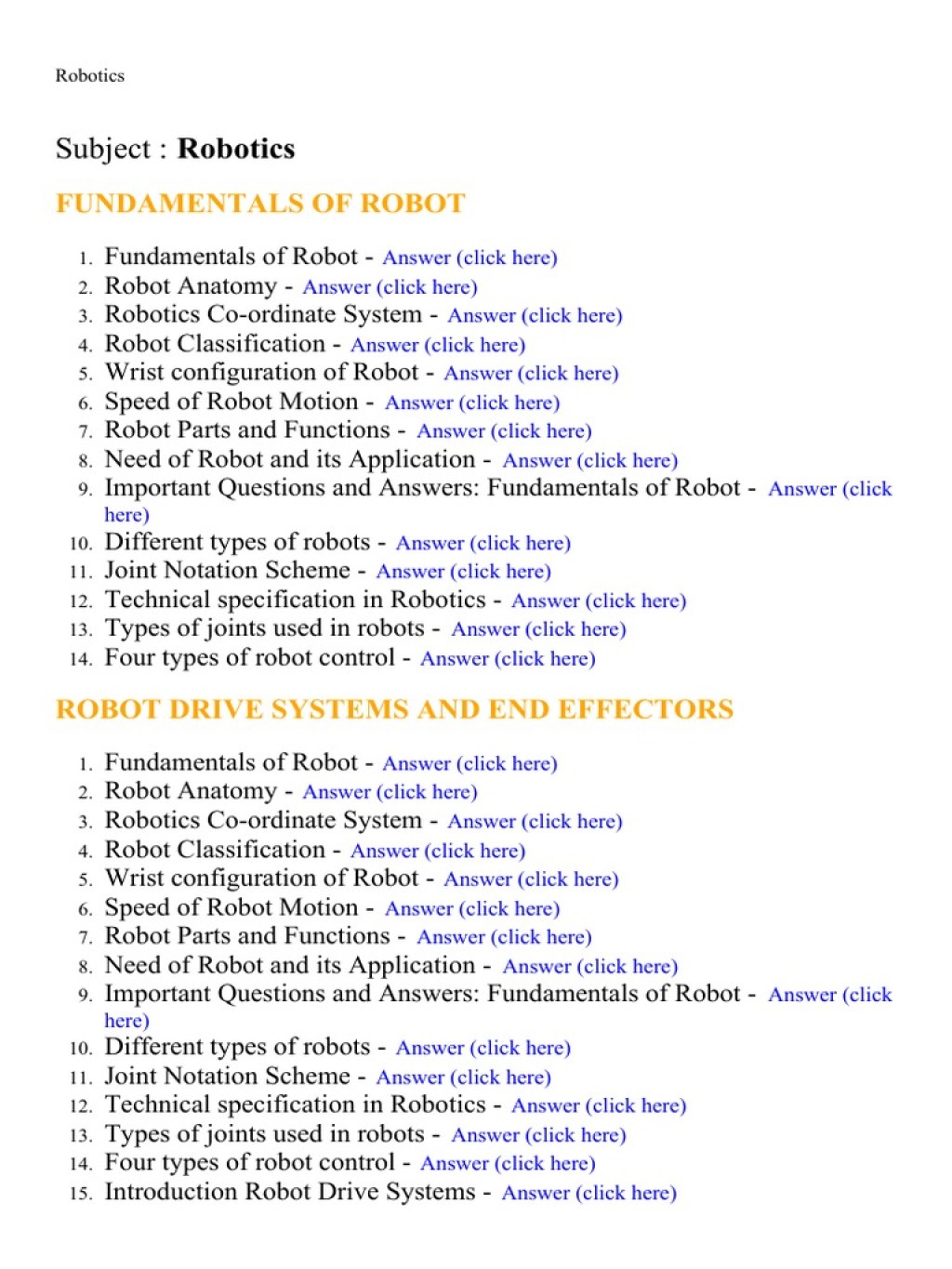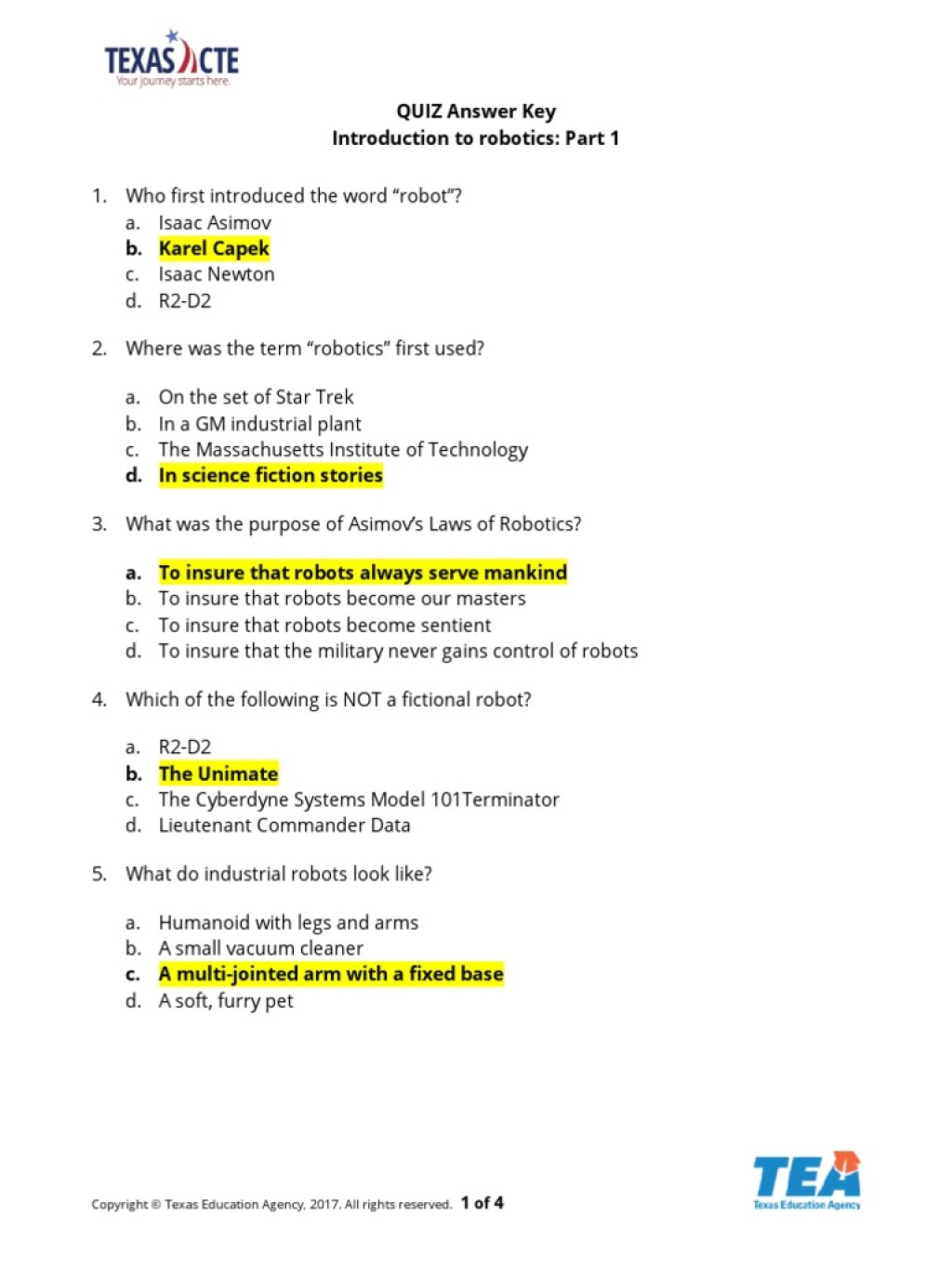Unraveling The World Of Robotics: Your Ultimate Guide To Robotics Questions And Answers – Click To Master The Art Of Robotics!
Robotics Questions and Answers
Introduction
Dear Readers,
2 Picture Gallery: Unraveling The World Of Robotics: Your Ultimate Guide To Robotics Questions And Answers – Click To Master The Art Of Robotics!


Welcome to our comprehensive guide on robotics questions and answers. In this article, we will explore various aspects of robotics and provide detailed answers to commonly asked questions. Robotics is an exciting field that combines engineering, computer science, and artificial intelligence to design, build, and program robots. As technology continues to advance, robots are becoming more integrated into our daily lives, from manufacturing and healthcare to exploration and entertainment.

Image Source: scribdassets.com
In this guide, we will answer questions such as what is robotics, who can pursue a career in robotics, when was robotics first introduced, where are robots used, why are robots important, and how do robots work. Additionally, we will discuss the advantages and disadvantages of robotics, address frequently asked questions, and provide a conclusion that encourages further exploration and learning.
What is Robotics?
Robotics is a multidisciplinary field that involves the design, construction, operation, and use of robots. A robot is a machine or an autonomous agent that can perform tasks or actions normally done by humans. These tasks can range from simple movements to complex problem-solving and decision-making processes. Robotics combines elements from various fields such as mechanical engineering, electrical engineering, computer science, and artificial intelligence to create intelligent machines capable of interacting with the physical world.
Who Can Pursue a Career in Robotics?
Anyone with an interest in technology, engineering, and problem-solving can pursue a career in robotics. Robotics offers a wide range of opportunities for individuals with different skill sets and backgrounds. Whether you have a passion for mechanical design, programming, or artificial intelligence, there is a place for you in the world of robotics. Robotics careers can be found in industries such as manufacturing, healthcare, transportation, and research. Additionally, robotics enthusiasts can also participate in robotics competitions and collaborate on open-source projects to further their skills and knowledge.
When Was Robotics First Introduced?

Image Source: scribdassets.com
The concept of robotics has been around for centuries, but the modern field of robotics as we know it today started to develop in the mid-20th century. In 1954, George Devol invented the first industrial robot, the Unimate, which was used in a General Motors plant for handling hot metal parts. This marked the beginning of industrial robotics and revolutionized the manufacturing industry. Since then, robotics has made significant advancements, and robots have become more sophisticated, intelligent, and versatile.
Where Are Robots Used?
Robots are used in various industries and sectors, including manufacturing, healthcare, agriculture, space exploration, entertainment, and education. In manufacturing, robots are used for assembly, welding, painting, and quality control. In healthcare, robots assist in surgeries, rehabilitation, and patient care. In agriculture, robots automate tasks such as planting, harvesting, and monitoring crops. In space exploration, robots are sent to explore distant planets and conduct scientific experiments. In entertainment, robots are used in theme parks, movies, and interactive exhibits. In education, robots are used to teach programming, problem-solving, and teamwork skills.
Why Are Robots Important?
Robots play a crucial role in today’s society and offer numerous benefits. They can perform tasks that are too dangerous, repetitive, or tedious for humans. Robots can work in extreme environments such as deep-sea exploration, space missions, and nuclear power plants. They can increase efficiency, productivity, and precision in industries such as manufacturing and healthcare. Robots can also assist individuals with disabilities, enhance the quality of life for the elderly, and improve the delivery of healthcare services. Additionally, robots have the potential to revolutionize industries, create new job opportunities, and drive economic growth.
How Do Robots Work?
Robots work based on a combination of hardware and software components. The hardware includes mechanical parts, sensors, actuators, and power sources. The software consists of programming languages, algorithms, and control systems. Robots perceive the environment through sensors, process the information using algorithms, and make decisions based on predefined rules or artificial intelligence algorithms. The actuators then execute the desired actions, such as moving, picking up objects, or performing specific tasks. The complexity of robot systems can vary, from simple robots with limited capabilities to advanced robots with human-like intelligence and autonomy.
Advantages of Robotics
1. Increased Efficiency: Robots can perform tasks faster and more accurately than humans, leading to increased productivity and reduced costs.
2. Improved Safety: Robots can handle dangerous or hazardous tasks, protecting human workers from potential harm.
3. Precision and Consistency: Robots can perform tasks with high precision and consistency, minimizing errors and variations.
4. Increased Production Capacity: Robots can work continuously without the need for breaks or rest, leading to higher production volumes.
5. Enhanced Quality: Robots can maintain consistent quality standards and reduce defects in manufacturing processes.
Disadvantages of Robotics
1. High Initial Costs: Implementing robotics systems can be expensive, requiring significant investments in equipment, training, and maintenance.
2. Job Displacement: As robots become more capable, there is a concern that they may replace human workers in certain industries, leading to job losses.
3. Technical Limitations: Robots may not be suitable for all tasks and environments, especially those that require human dexterity, adaptability, or creativity.
4. Ethical Considerations: The increasing use of robots raises ethical questions regarding privacy, data security, and the potential misuse or abuse of autonomous machines.
Frequently Asked Questions (FAQ)
Q: Can robots develop emotions?
A: Currently, robots do not possess emotions as humans do. Emotions are complex psychological states that arise from biological processes in humans. However, researchers are exploring the field of affective robotics, which aims to develop robots capable of understanding and expressing emotions in a limited way.
Q: Are robots capable of learning?
A: Yes, robots can learn through various techniques such as machine learning, artificial intelligence, and neural networks. By analyzing data and feedback from the environment, robots can adapt and improve their performance over time.
Q: Can robots replace human caregivers in healthcare?
A: While robots can assist in healthcare tasks, such as monitoring patients and providing reminders, they are not designed to replace human caregivers. Human interaction, empathy, and critical decision-making are essential aspects of healthcare that robots cannot fully replicate.
Q: What is the future of robotics?
A: The future of robotics is promising, with advancements in areas such as humanoid robots, swarm robotics, and collaborative robots (cobots). Robotics will continue to revolutionize industries, improve automation processes, and create new job opportunities in emerging fields.
Q: How can I start learning about robotics?
A: To start learning about robotics, you can explore online courses, attend workshops or robotics clubs, and experiment with robotics kits. Additionally, studying relevant subjects such as computer science, engineering, and mathematics can provide a solid foundation for understanding robotics principles and concepts.
Conclusion
In conclusion, robotics is a fascinating field that offers endless possibilities. From manufacturing to healthcare, robots are revolutionizing industries and transforming the way we live and work. By understanding the fundamentals of robotics and exploring the latest advancements, individuals can embark on a rewarding career in this exciting field. Whether you are interested in designing robots, programming their behaviors, or exploring the ethical implications of artificial intelligence, robotics has something to offer for everyone. We hope this guide has provided valuable insights and answered your burning questions about robotics.
Final Remarks
Dear Readers,
Thank you for joining us on this journey through the world of robotics. We hope you have found this guide informative and inspiring. Robotics is a rapidly evolving field, and there is much more to learn beyond what we have covered in this article. We encourage you to continue exploring and stay updated with the latest developments in robotics. Incorporate robotics into your daily life, whether it’s through learning, experimenting, or even building your own robot. Embrace the future of automation and technology, and let your curiosity drive you towards new horizons.
This post topic: Technology Innovation


